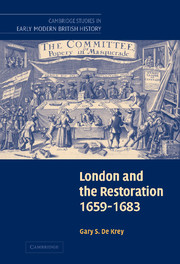Book contents
- Frontmatter
- Contents
- List of figures
- Map
- List of tables
- Preface
- List of abbreviations
- Part I Crisis, 1659–1660
- Part II Settlement and unsettlement, 1660–1679
- Part III Crisis, 1679–1682
- Part IV Crisis and conspiracy, 1682–1683
- Introduction: Whig conspiracy and historical memory
- 7 The London Whigs between law and resistance: conscience, consent, and conspiracy, 1682–1683
- Conclusion: London and the end of the Restoration
- Appendices
- Appendix I 1670 London dissenting subscription
- Appendix II London dissenting common councilmen, 1669–1671
- Appendix III Whig party leaders
- Appendix IV Tory party leaders
- Bibliography
- Index
- Titles in the series
7 - The London Whigs between law and resistance: conscience, consent, and conspiracy, 1682–1683
Published online by Cambridge University Press: 07 May 2010
- Frontmatter
- Contents
- List of figures
- Map
- List of tables
- Preface
- List of abbreviations
- Part I Crisis, 1659–1660
- Part II Settlement and unsettlement, 1660–1679
- Part III Crisis, 1679–1682
- Part IV Crisis and conspiracy, 1682–1683
- Introduction: Whig conspiracy and historical memory
- 7 The London Whigs between law and resistance: conscience, consent, and conspiracy, 1682–1683
- Conclusion: London and the end of the Restoration
- Appendices
- Appendix I 1670 London dissenting subscription
- Appendix II London dissenting common councilmen, 1669–1671
- Appendix III Whig party leaders
- Appendix IV Tory party leaders
- Bibliography
- Index
- Titles in the series
Summary
THE LOSS OF THE INITIATIVE
The London shrieval election of 1682 had brought the king and the Whigs to the brink of a confrontation unlike anything seen in the city since 1641–2, except the standoff between the Rump and the Corporation in 1659–60. Although the government believed it had begun the political reconstruction of the Corporation with the declaration of Tory sheriffs on 28 September, the London Whigs were reconciled neither to this result nor to the process that had achieved it. Moreover, the boundary dividing legal action and maneuvre from the outright defiance of authority had begun to dissolve as Whig anger mounted through the summer months of 1682. Whig citizens had accused Lord Mayor Moore of seeking to impose his “will” upon them, contrary to law. They claimed that unjust and unlawful force had been utilized in an electoral process and that a “military government” had been established over them. They accused loyalist magistrates of violating their oaths and their “trusts” to preserve the rights of citizens. Most ominously, Sheriff Pilkington had defended the people's right to “fortify” themselves in defense of their “Lives, Religion, and Liberty.” This was not the language of political acquiescence, and the London Whigs would have been surprised to learn that their contest with the crown was over.
City and Country Whigs were, nevertheless, not entirely agreed about how best to proceed in response to the “imposition” of magistrates upon the city.
- Type
- Chapter
- Information
- London and the Restoration, 1659–1683 , pp. 341 - 386Publisher: Cambridge University PressPrint publication year: 2005



